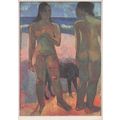Cuyp, Aelbert - Horsemen with Cows & Sheep near Dordrecht - art postcard
- Condition : Used
- Dispatch : 2 Days
- Brand : None
- ID# : 200319023
- Quantity : 1 item
- Views : 162
- Location : United Kingdom

- Seller : justthebook (+1699)
- Barcode : None
- Start : Wed 14 Apr 2021 14:24:47 (EDT)
- Close : Run Until Sold
- Remain : Run Until Sold
Checks/Cheques
 for 1 item(s) edit
for 1 item(s) edit
Shipping Calculator
More Listings from This Seller view all
Seller's Description
- Art Postcard
- Work of art title: Horsemen, with Cows and Sheep, near Dordrecht
- Artist (if known): Aelbert Cuyp
- Media or other details: painting
- Publisher / Gallery: Medici Society, London
- Postally used: no
- Stamp & postmark details (if relevant):
- Size: Modern
- Notes & condition details:
NOTES:
Size: 'Modern' is usually around 6in x 4in or larger / 'Old Standard' is usually around 5½in x 3½in. Larger sizes mentioned, but if you need to know the exact size please ask as this can vary.
All postcards are not totally new and are pre-owned. It's inevitable that older cards may show signs of ageing and use, particularly if sent through the post. Any faults other than normal ageing are noted.
Stock No.: A1108
Please ask if you need any other information and I will do the best I can to answer.
------------------------------------------------
Postage and packing charge should be showing for your location (contact if not sure).
UK - PayPal, Cheque (from UK bank) or postal order
I will give a full refund if you are not fully satisfied with the postcard.
----------------------------------------------
Aelbert Jacobsz. Cuyp (20 October 1620 – 15 November 1691) was one of the leading Dutch Golden Age painters, producing mainly landscapes. The most famous of a family of painters, the pupil of his father Jacob Gerritsz. Cuyp (1594–1651/52),[1] he is especially known for his large views of Dutch riverside scenes in a golden early morning or late afternoon light.
Cuyp was born in Dordrecht on 20 October 1620, and died there on 15 November 1691. Known as the Dutch equivalent of Claude Lorrain, he inherited a considerable fortune. His family were all artists, with his uncle Benjamin and grandfather Gerrit being stained glass cartoon designers. Jacob Gerritsz Cuyp, his father, was a portraitist.[2] Cuyp's father was his first teacher and they collaborated on many paintings throughout his lifetime.[3]
Little is known about Aelbert Cuyp's life. Even Arnold Houbraken, a noted historian of Dutch Golden Age paintings and the sole authority on Cuyp for the hundred years following his death, paints a very thin biographical picture.[4] His period of activity as a painter is traditionally limited to the two decades between 1639 and 1660, fitting within the generally accepted limits of the Dutch Golden Age's most significant period, 1640–1665. He is known to have been married to Cornelia Bosman in 1658, a date coinciding so directly with the end of his productivity as a painter that it has been accepted that his marriage played a role in the end of his artistic career.[5] The year after his marriage Cuyp became the deacon of the reformed church. Houbraken recalled that Cuyp was a devout Calvinist and the fact that when he died, there were no paintings of other artists found in his home.[6]
Sunlight in his paintings rakes across the panel, accentuating small bits of detail in the golden light. In large, atmospheric panoramas of the countryside, the highlights on a blade of meadow grass, the mane of a tranquil horse, the horn of a dairy cow reclining by a stream, or the tip of a peasant's hat are all caught in a bath of yellow ocher light. The richly varnished medium refracts the rays of light like a jewel as it dissolves into numerous glazed layers. Cuyp's landscapes were based on reality and on his own invention of what an enchanting landscape should be.
Cuyp's drawings reveal him to be a draftsman of superior quality. Light-drenched washes of golden brown ink depict a distant view of the city of Dordrecht or Utrecht. A Cuyp drawing may look like he intended it to be a finished work of art, but it was most likely taken back to the studio and used as a reference for his paintings. Often the same section of a sketch can be found in several different pictures.
Cuyp signed many of his works but rarely dated them, so that a chronology of his career has not been satisfactorily reassembled. A phenomenal number of paintings are ascribed to him, some of which are likely to be by other masters of the golden landscape, such as Abraham Calraet (1642–1722), whose initials A.C. may be mistaken for Cuyp's.
However, not everyone appreciates his work and River Landscape (1660), despite being widely regarded as amongst his best work, has been described as having "chocolate box blandness".[9]
At the Madrid's Thyssen-Bornemisza Museum most likely, the sole Cuyp's painting in Spanish public collections can be seen, a Landscape with a sunset ca. 1655 with animals.[10]
Listing Information
| Listing Type | Gallery Listing |
| Listing ID# | 200319023 |
| Start Time | Wed 14 Apr 2021 14:24:47 (EDT) |
| Close Time | Run Until Sold |
| Starting Bid | Fixed Price (no bidding) |
| Item Condition | Used |
| Bids | 0 |
| Views | 162 |
| Dispatch Time | 2 Days |
| Quantity | 1 |
| Location | United Kingdom |
| Auto Extend | No |


















